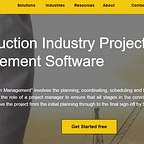Risk Assessment in Construction
Construction sites have inherent risks, no matter whether it is a multi storey building or a house renovation. Too often a realized risk can cause personal injury. Or, a serious risk not well managed can wipe out a whole company. Construction risk assessment and management is essential to successfully completing each building project.
Defining risk
A risk is an event that may or may not happen. Risk is uncertainty of an outcome that can cause construction project issues. No matter what the project, there is a certain amount of unavoidable risk. Risks are not hazards but they are events. Risks can refer to behavior, processes and procedures, and events. You need to decide what level of risk is acceptable in terms of value to the business.
Risks can include events that have:
- only negative variances or results — referred to as pure risk
- both negative and positive variances (eg. where there is a risk of loss or gain) — referred to as speculative risk
- only positive variances and the possibility of gain — these may not always be identified as risks.
Construction is a risky business. It is not possible to avoid all risks. Instead you must meet relevant legislation to manage, monitor, minimize and mitigate risks. For this you need easy to follow processes that help your organization and staff make the right decisions. So, you must complete a risk assessment to calculate the risks.
Managing construction risks
Managing risks is an important element of all construction projects. It involves completing a risk assessment of all work sites. It is important to assign each risk to the right people to take responsibility. There must be good processes and procedures in place to track and report on major risks.
There are four main aspects to managing construction risks:
- identifying risks:
· establish what risks can impact a project including:
· Occupational. Occupational risks include workers at risk of receiving an injury and possible death because of the actions of others, weather, unforeseen circumstances and procedures.
· Contractual. Contractual risks include penalties for not meeting milestone deadlines.
· Project. Project risks include inadequate processes and procedures, project resources and time management.
· Financial. Financial risks include interest rate rises, economic instability and insufficient funds.
· Natural. Natural risks include severe weather events, storms, floods and earthquakes.
· Stakeholder. Stakeholder risks include communication problems, misunderstandings about deliverables and punch lists at the end of a project.
· create and maintain a risk register.
- analyzing risks:
- assess the time and cost effects of each risk if it occurs — consider its probability of occurring and its impact on the project (time delays, cost)
- consider the likelihood of each risk occurring.
- responding to risks:
- involve all team members when assigning ownership of workplace risks
- address risks before they cause consequences
- put processes and procedures in place to monitor, manage and mitigate risks
- reduce the threat of a risk by either removing or minimizing its threat.
- reviewing risks:
- review and update risk information during the life of the project
- review risks to ensure to ensure adequate management of them.
Responding to risks
Once the construction risk assessment is complete, respond to the risks it identified. Construction risks are complex, but are still categorized as follows:
- Avoid accepting projects in flood prone areas during the wet season, for example.
- Use insurance and contract clauses to transfer risks.
- There are always safety hazards on a construction site. You can mitigate these with appropriate training and correct personal protective equipment for staff.
- Weather is a risk beyond anyone’s control. Good project management lessens the impact.
Using the right resources to manage risks
Selecting the right resources to help manage risks can help keep projects on track. New methods can eliminate and mitigate risks. Such as using drones to reduce safety hazards and prefabricated modules in buildings to reduce time spent with the building at risk to the weather.
Using the right management software can make managing construction risks easier and less time consuming. As a construction company grows, it takes on more projects simultaneously. Construction project risk assessment and management software integrates and links into all company projects to keep everyone on track for the life-cycle of each project.
